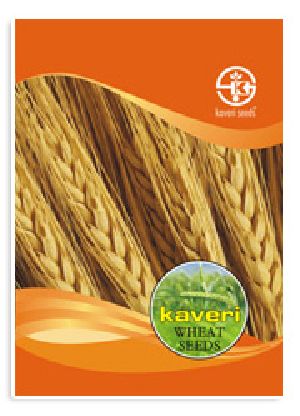
Wheat
The cultivation of wheat (Triticum spp.) reaches far back into history. Wheat was one of the first domesticated food crops and for 8000 years has been the basic staple food of the major civilizations of Europe, West Asia and North Africa. Wheat occupies major area under cultivation on the earth’s surface among the field crops and it is close third to rice and corn in total world production. Its production is mainly located in the temperate zones of developed and emerging countries. Today its production leads all crops, including rice, maize and potatoes. The optimum growing temperature is about 25°C, with minimum and maximum growth temperatures of 3° to 4°C and 30° to 32°C. Wheat contains minerals, vitamins and fats (lipids), and with a small amount of animal or legume protein added is highly nutritious. Although the so called bread wheats are common to most of us, there are many uncertainly related species that make up the genus Triticum. This likely was due to a number of natural crossings with wild species during its early evolvement. Some of the species closely related to our common wheats would be einkorn, emmer, durum, and spelt.
...more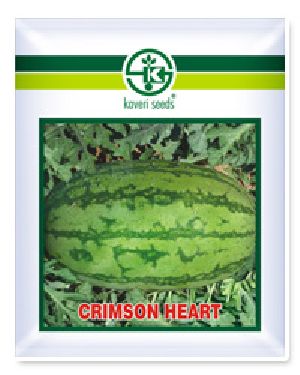
Watermelon
It is a warm season crop. It is widely grown in tropical and sub tropical and warm regions of the world. Presently for fresh consumption of juicy and fleshy mature fruits. Thus there is a need to improve high quality melons, it can be achieved partly due to good management practices. It is one of the most popularly grown fruit vegetable in the country today during summer. It is an excellent source of vitamin C, and A, beta carotene, antioxidant.
...more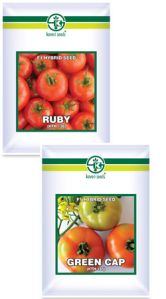
Tomatoes
Tomato is native to western South America. It is second most important vegetable next to potato. Tomatoes are now popular across the world, and became king of vegetables and their consumption is believed to benefit the heart, among other organs. They contain the carotene, lycopene one of the most powerful natural antioxidants. Tomatoes are also rich in vitamin C and also contains amount of potassium, iron, phosphorus, vitamin A & B. It is grown round the year under field and protected conditions. Generally it is used for culinary purpose and industrial value added products like Ketchup, Sauce etc.
...more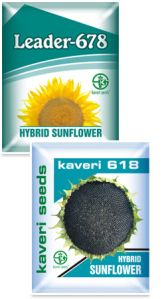
SunFlower
It is a recent introduction to India and shortly occupied as a prime oil seed crop, due to high heterosis. Number of hybrids developed by the public & private sector. It has a wider adaptability. It is a photo-insensitive crop thus it can be grown round the year. The oil is edible with a pleasant smell, and reduces the blood cholesterol. Generally it is grown under late Kharif and Rabi situations. Sunflower oil is rich in Vitamin E and low in saturated fat. It also contains monounsaturated and polyunsaturated fats along with vitamins that makes it one of the healthiest oils for consumption. High oleic sunflower oils contain 80% or more monounsaturated fats. Thus, sunflower oil helps in lowering cardiovascular diseases and chance of heart attack.
...more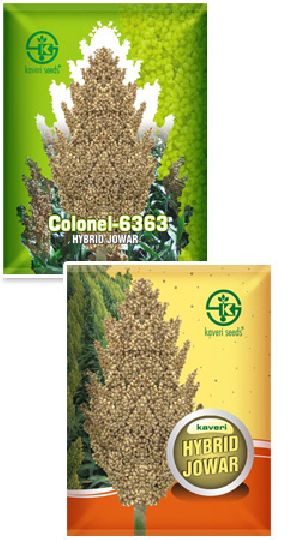
Sorghum
Sorghum is an indigenous crop to Africa, with domestication having taken place there around 5000 – 8000 years ago. It is a principle cereal crop of the world. It is the world`s fifth major cereals in terms of production and acreage. It is grown under semi-arid monsoonal tropical regions of the world. It is a drought tolerant crop; generally it is grown in Kharif rain-fed situations as well as irrigated situations. Few varieties are under Rabi situations. Sorghum yields are affected by the occurrence of aberrant climatic conditions. The crop genetically suited to hot and dry agro – ecologies where it is difficult to grow other food grains. Rich in Zinc and Iron content in sorghum.
...more
1121 white sella Rice
Rice originated in South East Asia. Agricultural population densities on Asians rice producing lands are among the highest in the world and continue to increase at a remarkable rate. Rapid population growth puts increasing pressure on the already strained food-producing resources. Rice is therefore on the frontline in the fight against world hunger and poverty. It is the primary staple for more than half the world population. Asia represents the largest producing and consuming region. In India consumer mostly prefer medium slender /short slender grain varieties. North India, hybrid rice is popular, while South India very negligible area. To make a Dent in hybrid rice cultivation in India, short to medium duration and resistant to major pests and diseases hybrid varieties with a fine grain type are needed. It should give 15-20% higher yield then only hybrid rice cultivation becomes remunerative. We have to develop and demonstrate, hybrid rice gives more yield and high buffering capacity. In most parts consumer preference is taste and quality rice. Rice is also a symbol of both cultural identity and global unity. The number of festivals, rituals, celebrations and recipes that are centered on this crop is noteworthy. For all of these reasons, "Rice is Life."
...more
Pulses
Pulses are an important constituent in local food crops in developing countries. They are the key source of protein in the diets of world’s poorest countries. In India, the commodity forms an important staple in vegetable based diet. In crop production system, pulses represent an input saving and resource conserving technology through biologically fixing nitrogen.
...more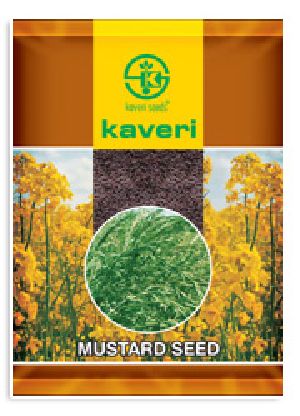
Mustard
Normally two types of mustard varieties are seen (i) Brassica hirta mainly generates the white and yellow types and (ii) Brassica juncea. is the main producer of mustard seeds like brown and oriental. All such mustard seeds reveal the prickly type of taste. The main origin of the mustard seed is Canada and then brought in America. It is assumed that mustard existence is five centuries earlier than Christian era. Mustard is an important spice in many regional foods and may come from one of three different plants: black mustard ( B. nigra), brown Indian mustard ( B. juncea) or white mustard (B. hirta). It has a religious significance, in the Bible Jesus tells the Parable of the Mustard Seed referring to faith and the Kingdom of God. The earliest reference to mustard is in India from a story of Gautama Buddha in the fifth century BC. Mustard grows well in temperate regions. Major producers include Canada, Nepal, Hungary, Great Britan, Pakistan and the USA. Mustard seed is a rich source of oil and protein. The seed has oil as high as 46-48%, and whole seed meal has 43.6% protein.
...more
Maize
Maize is the world’s primary coarse grain. It is a king of cereals. It has the ability to grow in diverse climates. Its production is concentrated in North America, especially the USA, South America and China. In India, Maize ranks as the most important food & feed crop next to rice and wheat. Major course grain of corn is used for animal feed. Presently single cross hybrids with wide adoptability revolutionized the production and productivity. (Corn production has nearly doubled in the last one and half decades largely due to the adoption of single cross hybrids).It’s penitrance to most of the non-traditional areas, thereby many fold area increased by replacing other field crops. Maize has a mind boggling multifarious end uses as food, feed and industrial by-products which is unmatched with any other crop.
...more
Hybrid Paddy Seeds
There are many varieties of rice and culinary preferences tend to vary regionally. For example in India, there is a saying that "grains of rice should be like two brothers, close but not stuck together" while in the Far East there is a preference for softer, stickier varieties. Because of its importance as a staple food, rice has considerable cultural importance. For example, rice is first mentioned in the Yajur Veda and then is frequently referred to in Sanskrit texts. Rice is often directly associated with prosperity and fertility, therefore there is the custom of throwing rice at weddings.
...more
Fresh Bottle Gourd
The Gourd Family (Cucurbitaceae) includes hundreds of species of vines bearing coiled, climbing tendrils and some of the most unusual fruits in the world. The total number of species may exceed 700, with at least 100 different genera. Known as "curcurbits" to gourd lovers, the fruits of this exceedingly diverse family come in an astounding array of shapes and sizes, from tiny, marble-sized "jumbie pumpkins". The gourd family also includes many economically important fruits and vegetables, including pumpkins, squash, melons and cucumbers. In addition, gourds are used by people throughout the world for musical instruments Bottle Gourd Researchers have discovered bottle gourd's remains from Mexican caves dating from 7000 BCE. Traces of this gourd have also discovered near Egyptian tombs belonging to the 4th millennium BCE. One of the oldest cultivated plants in the world, bottle gourd is a climbing plant which bears hard-shelled and bottle-shaped gourds as fruits. This delicious vegetable is also known by the names of bottle squash, calabash gourd, doodhi and lowki. Even today, its popularity graph is surging up and bottle gourds are widely used for preparing many delicious recipes. A rich source of vitamins, iron and minerals; it is an excellent diet for people having digestive problems. Since it contains low calories, bottle gourd is an awesome foodstuff for shedding extra calories and maintaining optimum health.
Country of Origin : India
Color : Green
...more
Cotton
Cotton is also known as “White Gold”. It is an important fiber crop of global significance, which is cultivated in tropical and sub-tropical region of more than 70 countries worldwide. The major producers of cotton are China, India, USA, Pakistan, Greece, Mexico and Turkey. These countries contribute about 85% percent to global cotton production. India is second largest producer of cotton. It plays a dominant role in the industrial and agricultural economy of the country. In India there are nine major cotton growing states which fall under three zones 1. North zone 2.Central zone 3. Southern zone. Being cash crop cotton is known for its intensive cultivation. Through the conventional breeding with the conjunct use of Biotechnology, BG-I & BG-II hybrids were developed in cotton, thus it replaced conventional hybrids and minimized the Bollworm attack.
...more
Chillies
Widely cultivated in tropical and sub tropical regions of the world. Temperature range from 20 to 32 degree centigrade is ideal for chilly. A warm humid climate favors the growth, while dry whether enhances fruit maturity. It is grown under rain fed and irrigated situations. It is used as green or dried fruits for culinary purposes. The fruits are rich in Vitamin A & C.
...more
Brinjal
Brinjal is a warm season crop; a long warm season is desirable for successful brinjal production and it is a hardy crop. It is widely grown and consuming vegetables in India. Many countries consider it as a poor man’s (meat) rich vegetables. Rich source of fiber, folic acid, calcium, potassium, contains vitamin C and B and minerals.
...more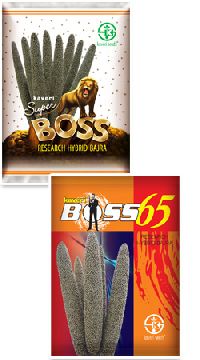
Bajra Seeds
There are many varieties of rice and culinary preferences tend to vary regionally. For example in India, there is a saying that "grains of rice should be like two brothers, close but not stuck together" while in the Far East there is a preference for softer, stickier varieties. Because of its importance as a staple food, rice has considerable cultural importance. For example, rice is first mentioned in the Yajur Veda and then is frequently referred to in Sanskrit texts. Rice is often directly associated with prosperity and fertility, therefore there is the custom of throwing rice at weddings.
...more
Bajra
Bajra is a hardy crop, suitable under semi-arid and arid zones and sustain well under stressful situations. It is used for dual purpose, grain & fodder. It is generally grown in Kharif and summer situations due to its wide adaptability. The major pearl millet growing states are Rajasthan, Maharashtra, Gujarat, Uttar Pradesh and Haryana.
...more
Maize Seeds

Sunflower Seeds

bazra plant seed

Okra
It is an important vegetable of the tropical countries and most popular in India, Nigeria, Pakistan, Cameroon, Iraq, Brazil and Ghana. It is grown in tropical and subtropical parts of the world. It is grown in Kharif as well as in summer conditions. It is cultivated extensively round the year for its immature fruits. Dependable yield and adaptability to varying moisture conditions. It is rich in vitamin A and folic acid, besides carbohydrates, phosphorus, magnesium and potassium and other mineral matters. The fruits are harvested when immature and eaten as vegetable.
...moreBe first to Rate
Rate ThisOpening Hours